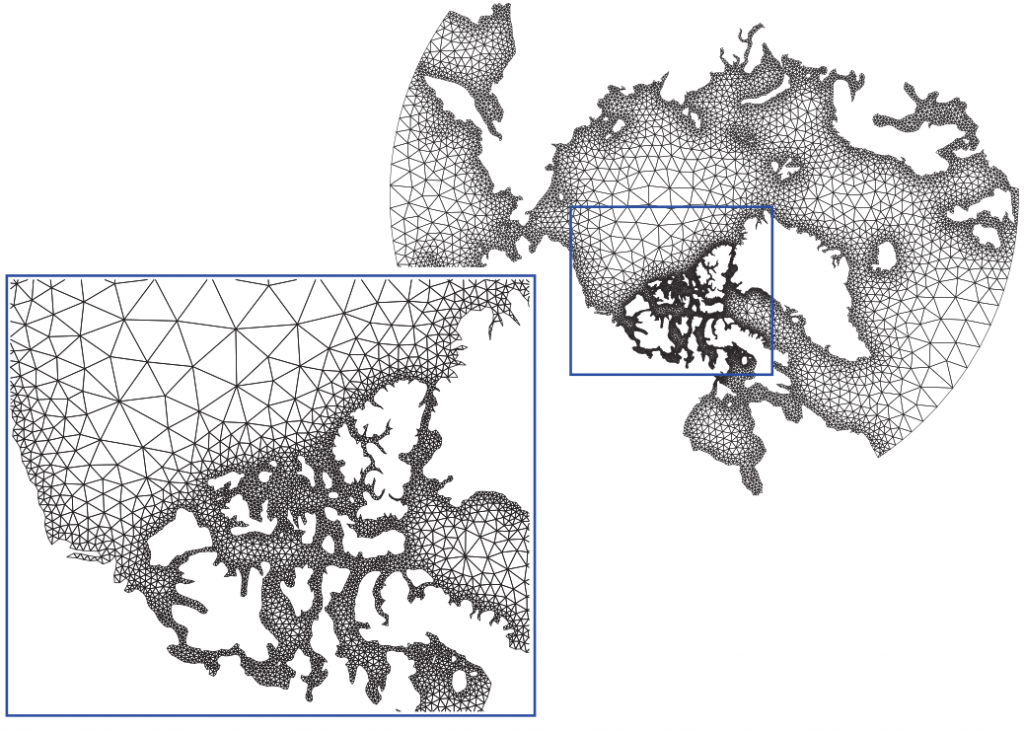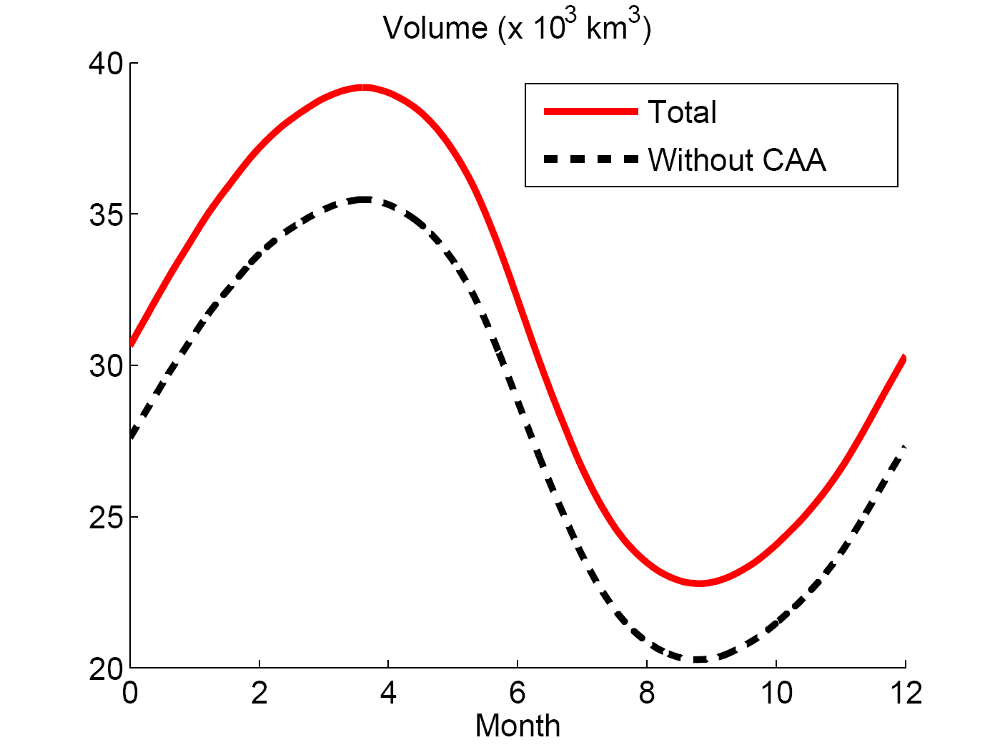The Canadian Arctic Archipelago (CAA) is a complex area formed by the numerous islands and coastlines. The straits within the CAA constitute an important pathway for the cold waters from the Arctic Ocean to the Atlantic. Unstructured meshes are well suited to study the impact of resolving the narrow straits of the CAA on sea-ice dynamics in the Arctic

SLIM currently has an uncoupled sea-ice model that represents both dynamic and thermodynamic processes and includes viscous-plastic rheology along with a complete parametrization of the atmospheric fluxes. Model results suggest that the CAA plays on significant role on the sea-ice budget in the Arctic as it accounts for about 10% of the total simulated sea-ice volume.

In order to maintain a good quality of the mesh, the mesh has to be adapted during the simulation, involving particular mesh adaptation techniques. This Lagrangian version of the model has several interesting applications, such as the dynamical mesh refinement along any region of interest (e.g., the ice edge), buoys tracking, or the inclusion of material properties in the rheology.
To learn more…
778265
caa
1
apa
50
date
desc
6363
https://www.slim-ocean.be/wp-content/plugins/zotpress/
%7B%22status%22%3A%22success%22%2C%22updateneeded%22%3Afalse%2C%22instance%22%3Afalse%2C%22meta%22%3A%7B%22request_last%22%3A0%2C%22request_next%22%3A0%2C%22used_cache%22%3Atrue%7D%2C%22data%22%3A%5B%7B%22key%22%3A%22DC9KBEAF%22%2C%22library%22%3A%7B%22id%22%3A778265%7D%2C%22meta%22%3A%7B%22creatorSummary%22%3A%22Lietaer%20et%20al.%22%2C%22parsedDate%22%3A%222011%22%2C%22numChildren%22%3A2%7D%2C%22bib%22%3A%22%26lt%3Bdiv%20class%3D%26quot%3Bcsl-bib-body%26quot%3B%20style%3D%26quot%3Bline-height%3A%202%3B%20padding-left%3A%201em%3B%20text-indent%3A-1em%3B%26quot%3B%26gt%3B%5Cn%20%20%26lt%3Bdiv%20class%3D%26quot%3Bcsl-entry%26quot%3B%26gt%3BLietaer%2C%20O.%2C%20Deleersnijder%2C%20E.%2C%20Fichefet%2C%20T.%2C%20Vancoppenolle%2C%20M.%2C%20Comblen%2C%20R.%2C%20Bouillon%2C%20S.%2C%20%26amp%3B%20Legat%2C%20V.%20%282011%29.%20The%20vertical%20age%20profile%20in%20sea%20ice%3A%20Theory%20and%20numerical%20results.%20%26lt%3Bi%26gt%3BOcean%20Modelling%26lt%3B%5C%2Fi%26gt%3B%2C%20%26lt%3Bi%26gt%3B40%26lt%3B%5C%2Fi%26gt%3B%283%26%23x2013%3B4%29%2C%20211%26%23x2013%3B226.%20%26lt%3Ba%20class%3D%26%23039%3Bzp-DOIURL%26%23039%3B%20href%3D%26%23039%3Bhttps%3A%5C%2F%5C%2Fdoi.org%5C%2F10.1016%5C%2Fj.ocemod.2011.09.002%26%23039%3B%26gt%3Bhttps%3A%5C%2F%5C%2Fdoi.org%5C%2F10.1016%5C%2Fj.ocemod.2011.09.002%26lt%3B%5C%2Fa%26gt%3B%26lt%3B%5C%2Fdiv%26gt%3B%5Cn%26lt%3B%5C%2Fdiv%26gt%3B%22%2C%22data%22%3A%7B%22itemType%22%3A%22journalArticle%22%2C%22title%22%3A%22The%20vertical%20age%20profile%20in%20sea%20ice%3A%20Theory%20and%20numerical%20results%22%2C%22creators%22%3A%5B%7B%22creatorType%22%3A%22author%22%2C%22firstName%22%3A%22Olivier%22%2C%22lastName%22%3A%22Lietaer%22%7D%2C%7B%22creatorType%22%3A%22author%22%2C%22firstName%22%3A%22Eric%22%2C%22lastName%22%3A%22Deleersnijder%22%7D%2C%7B%22creatorType%22%3A%22author%22%2C%22firstName%22%3A%22Thierry%22%2C%22lastName%22%3A%22Fichefet%22%7D%2C%7B%22creatorType%22%3A%22author%22%2C%22firstName%22%3A%22Martin%22%2C%22lastName%22%3A%22Vancoppenolle%22%7D%2C%7B%22creatorType%22%3A%22author%22%2C%22firstName%22%3A%22Richard%22%2C%22lastName%22%3A%22Comblen%22%7D%2C%7B%22creatorType%22%3A%22author%22%2C%22firstName%22%3A%22Sylvain%22%2C%22lastName%22%3A%22Bouillon%22%7D%2C%7B%22creatorType%22%3A%22author%22%2C%22firstName%22%3A%22Vincent%22%2C%22lastName%22%3A%22Legat%22%7D%5D%2C%22abstractNote%22%3A%22The%20sea%20ice%20age%20is%20an%20interesting%20diagnostic%20tool%20because%20it%20may%20provide%20a%20proxy%20for%20the%20sea%20ice%20thickness%20and%20is%20easier%20to%20infer%20from%20observations%20than%20the%20sea%20ice%20thickness.%20Remote%20sensing%20algorithms%20and%20modeling%20approaches%20proposed%20in%20the%20literature%20indicate%20signi%5Cufb01cant%20methodological%20uncertainties%2C%20leading%20to%20different%20ice%20age%20values%20and%20physical%20interpretations.%20In%20this%20work%2C%20we%20focus%20on%20the%20vertical%20age%20distribution%20in%20sea%20ice.%20Based%20on%20the%20age%20theory%20developed%20for%20marine%20modeling%2C%20we%20propose%20a%20vertically-variable%20sea%20ice%20age%20de%5Cufb01nition%20which%20gives%20a%20measure%20of%20the%20time%20elapsed%20since%20the%20accretion%20of%20the%20ice%20particle%20under%20consideration.%20An%20analytical%20solution%20is%20derived%20from%20Stefan%5Cu2019s%20law%20for%20a%20horizontally%20homogeneous%20ice%20layer%20with%20a%20periodic%20ice%20thickness%20seasonal%20cycle.%20Two%20numerical%20methods%20to%20solve%20the%20age%20equation%20are%20proposed.%20In%20the%20%5Cufb01rst%20one%2C%20the%20domain%20is%20discretized%20adaptively%20in%20space%20thanks%20to%20Lagrangian%20particles%20in%20order%20to%20capture%20the%20age%20pro%5Cufb01le%20and%20its%20discontinuities.%20The%20second%20one%20focuses%20on%20the%20mean%20age%20of%20the%20ice%20using%20as%20few%20degrees%20of%20freedom%20as%20possible%20and%20is%20based%20on%20an%20Arbitrary%20Lagrangian%5Cu2013Eulerian%20%28ALE%29%20spatial%20discretization%20and%20the%20%5Cufb01nite%20element%20method.%20We%20observe%20an%20excellent%20agreement%20between%20the%20Lagrangian%20particles%20and%20the%20analytical%20solution.%20The%20mean%20value%20and%20the%20standard%20deviation%20of%20the%20%5Cufb01nite%20element%20solution%20agree%20with%20the%20analytical%20solution%20and%20a%20linear%20approximation%20is%20found%20to%20represent%20the%20age%20pro%5Cufb01le%20the%20better%2C%20the%20older%20the%20ice%20gets.%20Both%20methods%20are%20%5Cufb01nally%20applied%20to%20a%20stand-alone%20thermodynamic%20sea%20ice%20model%20of%20the%20Arctic.%20Computing%20the%20vertically-averaged%20ice%20age%20reduces%20by%20a%20factor%20of%20about%202%20the%20simulated%20ice%20age%20compared%20to%20the%20oldest%20particle%20of%20the%20ice%20columns.%20A%20high%20correlation%20is%20found%20between%20the%20ice%20thickness%20and%20the%20age%20of%20the%20oldest%20particle.%20However%2C%20whether%20or%20not%20this%20will%20remain%20valid%20once%20ice%20dynamics%20is%20included%20should%20be%20investigated.%20In%20addition%2C%20the%20present%20study%2C%20based%20on%20thermodynamics%20only%2C%20does%20not%20support%20a%20single%20age-thickness%20functional%20relationship.%22%2C%22date%22%3A%221%5C%2F2011%22%2C%22language%22%3A%22en%22%2C%22DOI%22%3A%2210.1016%5C%2Fj.ocemod.2011.09.002%22%2C%22ISSN%22%3A%2214635003%22%2C%22url%22%3A%22http%3A%5C%2F%5C%2Flinkinghub.elsevier.com%5C%2Fretrieve%5C%2Fpii%5C%2FS1463500311001569%22%2C%22collections%22%3A%5B%22GJSQZPDC%22%5D%2C%22dateModified%22%3A%222018-09-09T13%3A58%3A01Z%22%7D%7D%2C%7B%22key%22%3A%228T34455G%22%2C%22library%22%3A%7B%22id%22%3A778265%7D%2C%22meta%22%3A%7B%22creatorSummary%22%3A%22Lietaer%20et%20al.%22%2C%22parsedDate%22%3A%222008%22%2C%22numChildren%22%3A2%7D%2C%22bib%22%3A%22%26lt%3Bdiv%20class%3D%26quot%3Bcsl-bib-body%26quot%3B%20style%3D%26quot%3Bline-height%3A%202%3B%20padding-left%3A%201em%3B%20text-indent%3A-1em%3B%26quot%3B%26gt%3B%5Cn%20%20%26lt%3Bdiv%20class%3D%26quot%3Bcsl-entry%26quot%3B%26gt%3BLietaer%2C%20O.%2C%20Fichefet%2C%20T.%2C%20%26amp%3B%20Legat%2C%20V.%20%282008%29.%20The%20effects%20of%20resolving%20the%20Canadian%20Arctic%20Archipelago%20in%20a%20finite%20element%20sea%20ice%20model.%20%26lt%3Bi%26gt%3BOcean%20Modelling%26lt%3B%5C%2Fi%26gt%3B%2C%20%26lt%3Bi%26gt%3B24%26lt%3B%5C%2Fi%26gt%3B%283%26%23x2013%3B4%29%2C%20140%26%23x2013%3B152.%20%26lt%3Ba%20class%3D%26%23039%3Bzp-DOIURL%26%23039%3B%20href%3D%26%23039%3Bhttps%3A%5C%2F%5C%2Fdoi.org%5C%2F10.1016%5C%2Fj.ocemod.2008.06.002%26%23039%3B%26gt%3Bhttps%3A%5C%2F%5C%2Fdoi.org%5C%2F10.1016%5C%2Fj.ocemod.2008.06.002%26lt%3B%5C%2Fa%26gt%3B%26lt%3B%5C%2Fdiv%26gt%3B%5Cn%26lt%3B%5C%2Fdiv%26gt%3B%22%2C%22data%22%3A%7B%22itemType%22%3A%22journalArticle%22%2C%22title%22%3A%22The%20effects%20of%20resolving%20the%20Canadian%20Arctic%20Archipelago%20in%20a%20finite%20element%20sea%20ice%20model%22%2C%22creators%22%3A%5B%7B%22creatorType%22%3A%22author%22%2C%22firstName%22%3A%22Olivier%22%2C%22lastName%22%3A%22Lietaer%22%7D%2C%7B%22creatorType%22%3A%22author%22%2C%22firstName%22%3A%22Thierry%22%2C%22lastName%22%3A%22Fichefet%22%7D%2C%7B%22creatorType%22%3A%22author%22%2C%22firstName%22%3A%22Vincent%22%2C%22lastName%22%3A%22Legat%22%7D%5D%2C%22abstractNote%22%3A%22Though%20narrow%20straits%20may%20have%20a%20strong%20in%5Cufb02uence%20on%20the%20large-scale%20sea%20ice%20mass%20balance%2C%20they%20are%20often%20crudely%20represented%20in%20coarse%20resolution%20sea%20ice%20models.%20Unstructured%20meshes%2C%20with%20their%20natural%20ability%20to%20%5Cufb01t%20boundaries%20and%20locally%20increase%20the%20mesh%20resolution%2C%20propose%20an%20alternative%20framework%20to%20capture%20the%20complex%20oceanic%20areas%20formed%20by%20coasts%20and%20islands.%20In%20this%20paper%2C%20we%20develop%20a%20%5Cufb01nite%20element%20sea%20ice%20model%20to%20investigate%20the%20sensitivity%20of%20the%20Arctic%20sea%20ice%20cover%20features%20to%20the%20resolution%20of%20the%20narrow%20straits%20constituting%20the%20Canadian%20Arctic%20Archipelago.%20The%20model%20is%20a%20two-level%20dynamic-thermodynamic%20sea%20ice%20model%2C%20including%20a%20viscous-plastic%20rheology.%20It%20is%20run%20over%201979%5Cu20132005%2C%20forced%20by%20daily%20NCEP%5C%2FNCAR%20reanalysis%20data.%20Confronting%20qualitatively%20numerical%20experiments%20with%20observations%20shows%20a%20good%20agreement%20with%20satellite%20and%20buoys%20measurements.%20Due%20to%20its%20simple%20representation%20of%20the%20oceanic%20interactions%2C%20the%20model%20overestimates%20the%20sea%20ice%20extent%20during%20winter%20in%20the%20southernmost%20parts%20of%20the%20Arctic%2C%20while%20the%20Baf%5Cufb01n%20Bay%20and%20Kara%20Sea%20remain%20ice-covered%20during%20summer.%20In%20order%20to%20isolate%20the%20bene%5Cufb01ts%20from%20resolving%20the%20Canadian%20Arctic%20Archipelago%2C%20a%20numerical%20experiment%20is%20performed%20where%20we%20arti%5Cufb01cially%20close%20the%20archipelago.%20Focusing%20on%20the%20large-scale%20sea%20ice%20thickness%20pattern%2C%20no%20signi%5Cufb01cant%20change%20is%20found%20in%20our%20model%2C%20except%20in%20the%20close%20surroundings%20of%20the%20archipelago.%20However%2C%20the%20local%20and%20shortterm%20in%5Cufb02uences%20of%20the%20ice%20exchanges%20are%20nonnegligible.%20In%20particular%2C%20we%20show%20that%20the%20ice%20volume%20associated%20to%20the%20Canadian%20Arctic%20Archipelago%20represents%2010%25%20of%20the%20Northern%20Hemisphere%20sea%20ice%20volume%20and%20that%20the%20annual%20mean%20ice%20export%20towards%20Baf%5Cufb01n%20Bay%20amounts%20to%20125%20km3%20yr%5Cu00c01%2C%20which%20may%20play%20an%20important%20role%20on%20the%20convective%20overturning%20in%20the%20Labrador%20Sea.%22%2C%22date%22%3A%221%5C%2F2008%22%2C%22language%22%3A%22en%22%2C%22DOI%22%3A%2210.1016%5C%2Fj.ocemod.2008.06.002%22%2C%22ISSN%22%3A%2214635003%22%2C%22url%22%3A%22http%3A%5C%2F%5C%2Flinkinghub.elsevier.com%5C%2Fretrieve%5C%2Fpii%5C%2FS146350030800084X%22%2C%22collections%22%3A%5B%22GJSQZPDC%22%5D%2C%22dateModified%22%3A%222018-09-09T13%3A55%3A41Z%22%7D%7D%5D%7D
Lietaer, O., Deleersnijder, E., Fichefet, T., Vancoppenolle, M., Comblen, R., Bouillon, S., & Legat, V. (2011). The vertical age profile in sea ice: Theory and numerical results.
Ocean Modelling,
40(3–4), 211–226.
https://doi.org/10.1016/j.ocemod.2011.09.002
Lietaer, O., Fichefet, T., & Legat, V. (2008). The effects of resolving the Canadian Arctic Archipelago in a finite element sea ice model.
Ocean Modelling,
24(3–4), 140–152.
https://doi.org/10.1016/j.ocemod.2008.06.002

